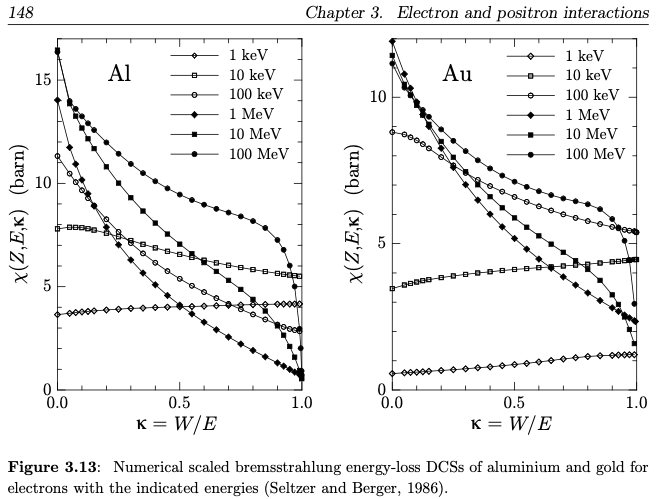... So the appearance of this so-called photon cliff should not surprise us.
... it had surprised me the first time I saw it from simulation and it still surprises me, even if it should not. I highly suspect it to be an artifact of modeling.
We already know it is not an artifact of modeling, according to Llovet, Ducharme, Ritchie and Rohde (it's actually a "binning" artifact if we assume non-zero width bins), and it should not surprise you because of what was posted previously:
Yeah, I'm always shocked! And it is weird that an electron could come to a complete halt. Here is a figure that a colleague of mine in the Physics Department at the University of Oregon , Andrew Ducharme, wrote me recently in discussing the above photon "cliff":
The established physics is that bremsstrahlung cross-sections are nonzero for complete energy losses, or for production of photons with the beam energy E (see figure from Penelope manual), while the probability of producing a photon with energy E + 1 eV is 0. Wait long enough (assuming ideal detector, electron source) and you will count photons at the Duane-Hunt limit while never getting counts in the energy bin of E + 1 eV. The longer you wait, the more DH-energy photons, and the higher the cliff.

I think of it in the sense that the coulombic field of an atom is actually a pretty big target, so a few electrons are going to hit some atoms directly right at the surface...
Note that the cross sections at complete loss of energy by the electron (at 1.0 on the x axis) are non-zero. The implication of this is that it is possible to produce continuum photons up to and at the electron beam energy, but impossible to produce photons above the electron beam energy. That means that
if we collect photons into bins of a non-zero width, the appearance of a photon cliff is inevitable, even if that photon cliff is obscured by the (limited) spectral convolution of our photon detector. This is the reason why we only observe the photon cliff in unconvolved simulations and when not using a continuous slowing down model (CSDA). PENEPMA uses a discrete energy loss model so the photon cliff becomes apparent in simulations with sufficient electron trajectories.
However as you suggest, using a micro-calorimeter EDS could be a good idea as the authors claimed an ~10 eV spectral resolution:
D. A. Wollman, G. C. Hilton, K. D. Irwin, L. L. Dulcie, N. F. Bergren, Dale E. Newbury, Keung-Shan Woo, Benjamin Y. H. Liu, Alain C. Diebold, John M. Martinis; High-resolution microcalorimeter energy-dispersive spectrometer for x-ray microanalysis and particle analysis. AIP Conf. Proc. 24 November 1998; 449 (1): 799–804.
https://doi.org/10.1063/1.56867But I'm not sure who still has one up and running? But if anyone does it would be an easy (and cool!) measurement, just use 10 eV wide energy channels and the photon cliff should appear given enough acquisition time.